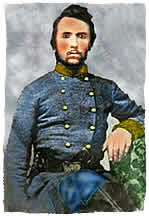|
The
3rd Texas was concealed beneath some rugged bluffs over looking
the Yazoo. Ross open up with his artillery and the battle
was on. The battle continued till dusk and resumed the next
day. The battle still continued as the brigade shifted down
stream and attacked as the river bends. The advance was effectively
delayed and the Texas Brigade was herald as heroes from the
nearby town.
Mission
to Mission
Ross’s
Texas brigade was heavily engaged throughout the war and was
never able to rest long. They were sent back toward their
previous campground to reconnoiter which was in an area overlooking
the Yazoo River. There on the 28th of February they engaged
a Federal Cavalry force of about forty men who had stumbled
up on a whole Confederate brigade. They opened fired and then
withdrew. They were mounted on mules and no match for the
Rebel Cavalry and were outflanked and destroyed.
On
March 5th, having been joined by some 550 Tennessee Cavalrymen
the Texas Brigade attacked the Federal Forces under the Command
of Major George McKee. The overwhelmed them and the battle
lasted for a day until nightfall. Yankee re-enforcement’s
arrived the next morning fortifying the resistance to odds
in favor of the Yankees.
The
3rd Texas Cavalry was to be a part of one more mission before
leaving the area. The were part of a raid on Syder’s
Bluff where they were to destroy a plantation to keep it’s
cotton from falling into enemy hands. The raid was conducted
with the 9th Texas Cavalry and was highly successful. They
hit a squadron of Black cavalry, dispersed them, killing some
30 of them, destroyed all of the equipment, burned the gin,
captured about a hundred mules and rode back unscathed.
General
Red Jackson’s Division, of whom the Texas Brigade was
part, was ordered by General Polk to proceed to Tuscaloosa,
Alabama. They arrived on took up the line on April 4th 1864.
Seeing
duty as pickets and reconnaissance, Ross’s Texas Brigade
was sent with the Army of Mississippi to Rome Georgia. On
May 4th, the Texans proceeded and rode 150 miles arriving
on May 14th. The next day they went into battle. They were
to be engaged continuously for the next 112 days.
 |
Private
Lon Cartwright served in Company
E of the 3rd Texas and rose in the ranks. He is seated
here in a poised image taken in mid-war. He wears an officer’s
frock coat and knee high cavalry boots. He is wearing
the regulation 1851 officer’s belt and buckle and
is armed with a revolver. Though hard to make out, he
also has a sheaf knife in his belt as well. |

Part
1 | Part
2 | Part
3 | Part
4 |
Part 5
Part
6| Part
7 |
Part 8| Part
9| Part
10
Part
11 |
Part 12 | Part
13
|